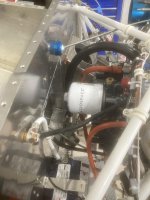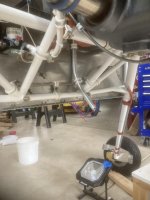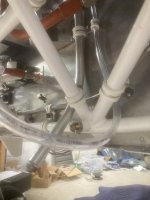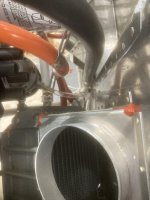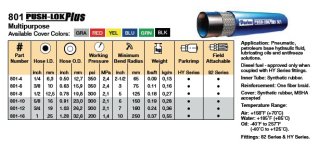Desert Rat
Well Known Member
The subject of how Vans supplies a non-oil compatible heater hose to serve as a breather line has been discussed to death, but I thought I'd throw out my solution on a new thread in case it might help somebody out in the future.
My engine came from Lycoming with a brass 3/4" nipple installed in the breather port. Vans would have you cut a rubber elbow off a Napa automotive heater hose and connect it between this fitting and the end of their aluminum down spout which is necked up at the upper end specifically to allow it to mate to a 3/4" hose, then immediately chokes down to 5/8" for the rest of it's run.
The issue people have with this is that the heater hose isn't rated for oil products and will degrade over time, much more than a suitable material.
My solution was to just replace the straight 3/4" brass nipple with an AN844-10 that I got from Airparts for about $20. Yes, it can be done on an engine thats already hung (barely).
I then cut the vans downspout right below the upper curve and just used the bottom part. I attached it at the vans print location and at the engine mount with adel clamps, and connect the AN844 and the downspout with about 18" of Mil-6000 hose.
I don't have the exhaust yet, so this may need to move up a bit for clearance, which is why there aren't any hose clamps on the assembly, nor have I drilled a whistle hole yet.
The clear vinyl line is the drain for the fuel pump bypass. For a fitting, I just used a 1/4" hose barb from the plumbing section of Ace hardware.
I elected to try a vinyl hose here because it's clear and I'd like for it to be obvious if fuel is starting to bypass.
I looked up the specs on vinyl and it's good to 160* which seems like it should be plenty. However, this routing has it passing within about 1" of the oil cooler so I'll keep an eye on it and if it seems like it's getting too hot there I might replace it with something more robust in the future.
I hope that if somebody is looking for an alternative to the factory solution this might be of some help.
My engine came from Lycoming with a brass 3/4" nipple installed in the breather port. Vans would have you cut a rubber elbow off a Napa automotive heater hose and connect it between this fitting and the end of their aluminum down spout which is necked up at the upper end specifically to allow it to mate to a 3/4" hose, then immediately chokes down to 5/8" for the rest of it's run.
The issue people have with this is that the heater hose isn't rated for oil products and will degrade over time, much more than a suitable material.
My solution was to just replace the straight 3/4" brass nipple with an AN844-10 that I got from Airparts for about $20. Yes, it can be done on an engine thats already hung (barely).
I then cut the vans downspout right below the upper curve and just used the bottom part. I attached it at the vans print location and at the engine mount with adel clamps, and connect the AN844 and the downspout with about 18" of Mil-6000 hose.
I don't have the exhaust yet, so this may need to move up a bit for clearance, which is why there aren't any hose clamps on the assembly, nor have I drilled a whistle hole yet.
The clear vinyl line is the drain for the fuel pump bypass. For a fitting, I just used a 1/4" hose barb from the plumbing section of Ace hardware.
I elected to try a vinyl hose here because it's clear and I'd like for it to be obvious if fuel is starting to bypass.
I looked up the specs on vinyl and it's good to 160* which seems like it should be plenty. However, this routing has it passing within about 1" of the oil cooler so I'll keep an eye on it and if it seems like it's getting too hot there I might replace it with something more robust in the future.
I hope that if somebody is looking for an alternative to the factory solution this might be of some help.



